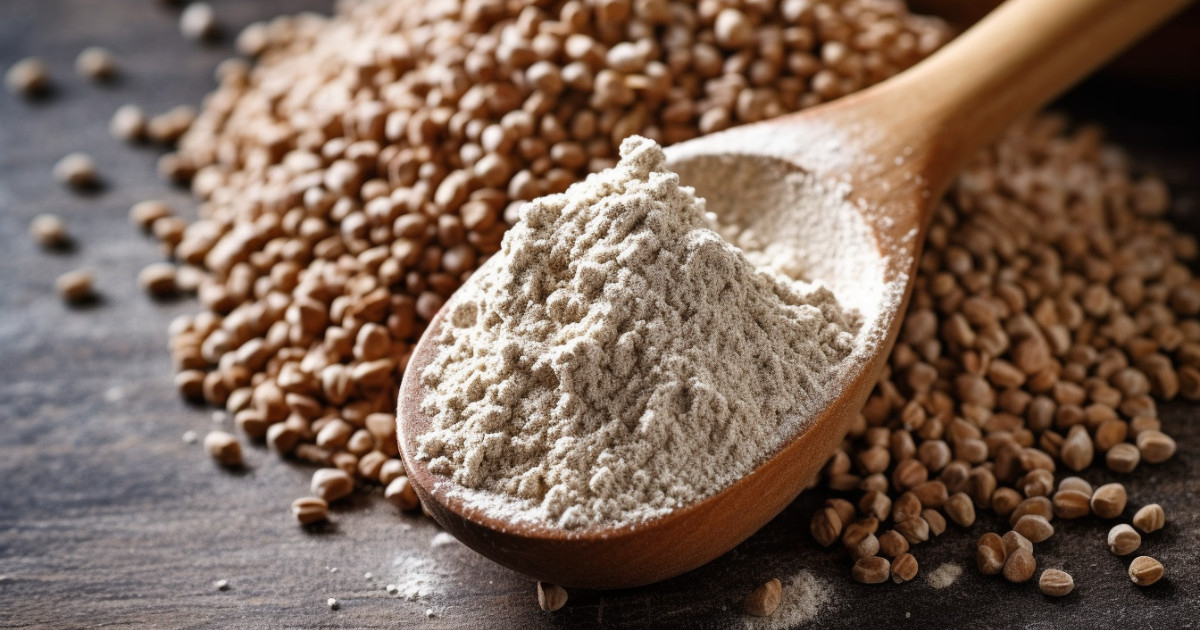The buckwheat flour’s health benefits include being alkaline-forming, nutrient-dense and full of fibre. Despite its name, it is gluten-free. Buckwheat four is a healthier option than normal flour, particularly if you have an intolerance to gluten.
Buckwheat Flour Health Benefits
There is a higher degree of nutritional value in buckwheat with it typically consisting of the following values per 100g:
| Protein | 13.1 g |
| Carbohydrates | 70.9 g |
| Dietary Fiber | 10.6 g |
| Calories | 339 kcals |
| Moisture Content | 9.7 % |
| Sugars | nil |
| Lipid Fats | 3.3 g |
| Trans Fats | nil |
| Saturated Fats | 0.71 g |
| Polyunsaturated Fats | 0.98 g |
| Monounsaturated Fats | 1.01 g |
| Omega 3 | 0.09 g |
| Omega 6 | 0.94 g |
Buckwheat has been getting more popular and people are realizing that it is more than a simple staple. People have been asking, about buckwheat flour’s health benefits, particularly is buckwheat flour healthy and does buckwheat flour has gluten.
Firstly we should tell you a bit about Buckwheat and answer those questions as we go along.
Buckwheat (Fagopyrum esculentum) is a seed called groats and is a pseudocereal crop, related to sorrel and rhubarb. As Buckwheat is a seed and not a grain, so it’s not wheat at all. 1
It contains no gluten and can be used as an alternative to wheat flour in pasta, noodles, baking and other foods that we would traditionally use wheat flour in.
In Central and Eastern European diets, the hulled kernel’s, when dry roasted are known as Kasha. They are used similarly to whole barley or rice and eaten as cereals or made into porridge.
Buckwheat can be eaten whole or ground into flour and used in cooking and baking. Did you know that Kasha is also the name used for mixed-grain cereal porridge?
Buckwheat as a crop
Buckwheat crops can be grown in acidic and unfertilized soils. The crops are sometimes used to keep weeds at bay. The crops help to keep soil erosion down during crop rotation and the field rest periods.
Buckwheat is sown in June to grow during the summer months in the northern hemisphere. The crop blooms for several months, producing valuable nectar for bees providing late-season honey.
After the groats are harvested the stalks can be tilled into the ground helping to retain moisture in the soil or can be dried and stored for stock feed.
Nutrients in Buckwheat
When asked about buckwheat flour’s health benefits, and is buckwheat flour healthy the answer would be a resounding yes.
Buckwheat flour is a great source of fibre, high in antioxidants, and provides a rich supply of nutrients including high levels of zinc, copper, and manganese compared to other cereal grains.
It also contains potassium which is known to help maintain water and acid in the blood and tissue cells.
After oats, buckwheat has a high level of protein, is rich in lysine and has one of the highest plant amino acid scores of 100.
Evidence has shown that the protein in buckwheat can be difficult to digest so although it is good for adults; it is a less ideal source of protein for children and people with digestive issues.
As we should get our proteins from a variety of sources it can be added to our varied diets with ease. I like the add buckwheat and chia seeds to my oats for breakfast.
Fiber in buckwheat
In the quest for information to answer the question ‘Is Buckwheat Flour Healthy?’ in 2001 a Slovenian study was conducted, to identify buckwheat flour’s health benefits and nutritional content.
The participants consumed boiled buckwheat groats or bread made with at least 50% of buckwheat flour. After a meal (postprandial) it showed that buckwheat induced a lower blood glucose, making it lower GI (Glycemic Index) and insulin resistance response than white wheat bread. 2
A study over two months showed that the consumption of buckwheat helped lower insulin resistance and helped to control blood sugar levels. As buckwheat is high in soluble fiber it assists in slowing the rate of glucose absorption which is also good for diabetics.
Over the years I have tried a few different approaches to improving the fiber in my diet. One of the best things that I have done was to use a colon cleanse blend with Chia Seed and Buckwheat in it to help with digestion.
This has helped me purge unwanted toxins from my system, and feel much lighter and clearer.
Buckwheat has been found to have various health benefits, including:
- Helps prevent and manage diabetes
- Helps improve heart health
- Helps lower LDL cholesterol
- Stabilises blood pressure levels
- Helps lower inflammation
Uses for Buckwheat
Buckwheat has many uses. Due to its many health benefits, it is often used as a medicine or preventative medicine. The pollen from the buckwheat flowers is collected by bees to make honey.
Buckwheat grout has been used as an alternative to grains in gluten-free beers. You can even buy buckwheat pillows.
We spend a third of our lives in bed, so having a suitable pillow is essential for a good night’s sleep. The zipper on the pillowcase allows you to add/remove the Buckwheat hull filling to a suitable thickness.
The pillow contours to your head and neck for extra support and comfort, and may reduce snoring, tension, neck pain, headaches and ear pain for side sleepers. Buckwheat is hypo-allergenic (not likely to cause an allergic reaction) and environmentally friendly.
What is resistant starch in buckwheat?
Resistant starch in foods occurs naturally. In healthy people, when resistant starch enters the small intestine, it has a similar effect as dietary fiber, functioning as a mild laxative and may cause gastric pain or flatulence if over consumed.
There are four different types of resistant starch, generally speaking. Buckwheat is a resistant starch type 1. The areas where the other resistant starch types can be found include:
- Resistant starch type one – this can be found in seeds, legumes, and grains. This starch resists digestion as it is confined, or bound in the fibrous cell walls.
- Resistant starch type two – this can be found in unripened green bananas and raw potatoes. Allowing a banana to ripen will effectively change the nature of the starch from being resistant to regular starch.
- Resistant starch type three – is formed as a part of the cooling process when foods such as potatoes are cooked and allowed to cool. As a part of the cooling process, some of the starch that would have previously been digestible is converted to be resistant via a process of retrogradation.
- Resistant starch type four – is a type of starch that is manufactured through man-made chemical processes.
To be completely accurate, several different types of starch are resistant and can be found within the same foods. They are not specifically exclusive.
In consideration of the questions, is buckwheat flour healthy and does buckwheat have gluten is evidenced by the information given by http://nutritiondata.self.com on their nutrient content page and its uses in whole foods and cooking.
Buckwheat flour is nutritious and energising. The beneficial effects of buckwheat have made this little seed a highly effective superfood.
Reference
- “Pseudocereal grains: Nutritional value, health benefits and current applications for the development of gluten-free foods” – C. Villaluenga, E. Peñas, B. Ledesma, 5 February 2020 [PubMed] [Archive] ↩︎
- “Glycemic Index Foundation Welcomes New Board Members” – GIF Staff, 29 September 2020 [Glycemix Index Foundation] [Archive] ↩︎
Last Updated on 2 months by D&C Editorial Team




